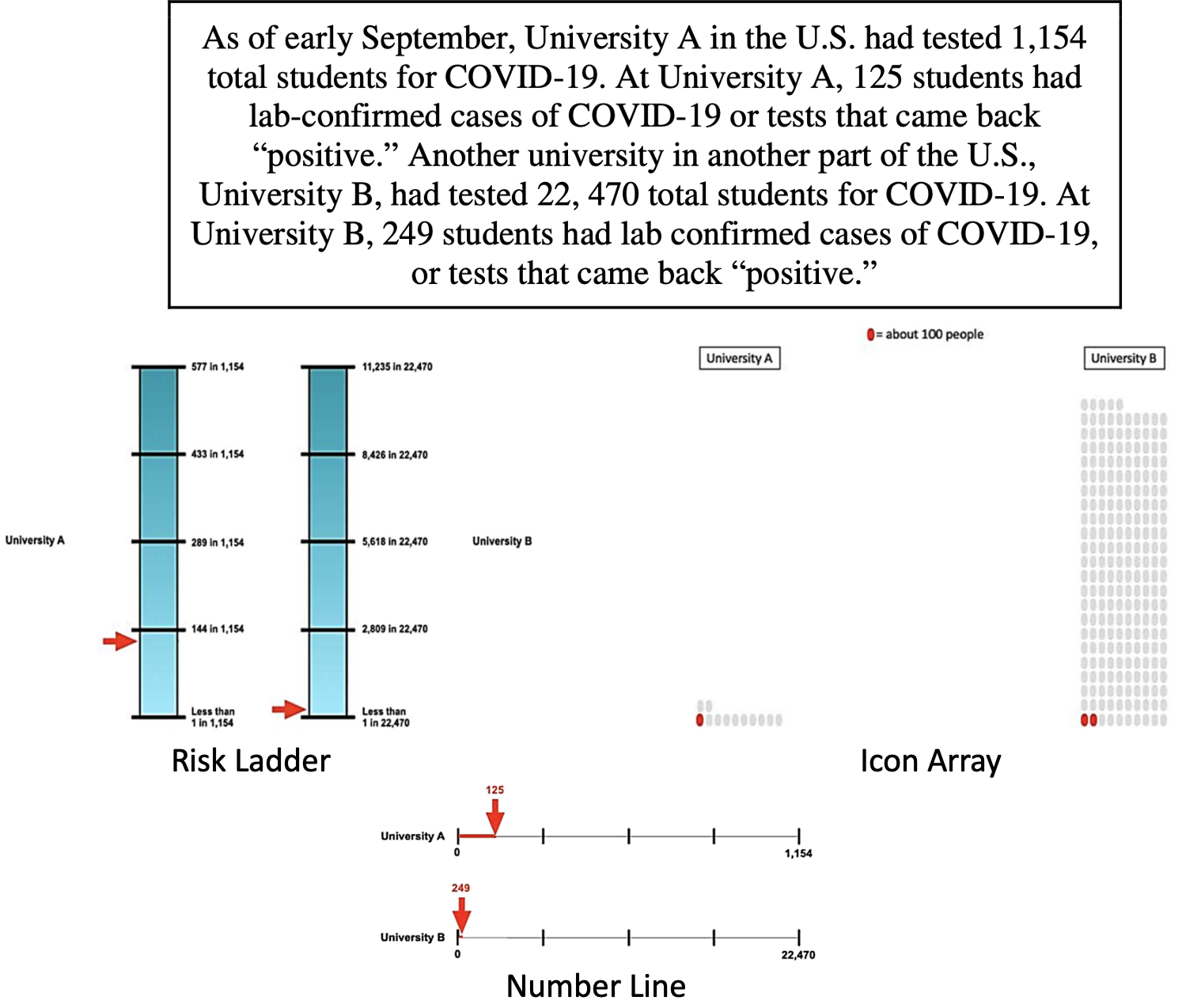It’s crunch time.
Two weeks left in the semester, and Sasha is running on coffee, with limited sleep and even less available time. To make matters worse, she has extra-credit assignments coming up in two of her courses, and she came to the unfortunate conclusion that the assignments will take about the same amount of time, and she will only have time to do one of them. She earned 302 points in a course with 387 total points and 780 points in a course with 1,000 total points. The assignment in the 387-point course is worth 8 points, and the assignment in the 1,000-point course is worth 15 points. Which one should she do?
Many factors affect Sasha’s decision. For example, one class might be in her major, and the grade in that course might be more important to her than the grade in the elective course. However, in order for Sasha to accurately weigh her options, she must understand the numerical information involved in her decision: She must understand the grading scales.
Grading scales–the instructor-chosen systems for evaluating student’s progress in a course–might seem like an uninfluential component of course design – a necessary component of the syllabus and nothing else. Indeed, at least one instructor in the Society for the Teaching of Psychology Facebook group commented that instructors should be able to use any grading scale they want because students should know how to do the math. Maybe they should. Perhaps the education system failed these students to some degree. But should they be graded on knowing the math in an Introduction to Psychology course? We argue they should not.
Grading scales and numerical misconceptions
Some people might find grading-scale math to be rudimentary, but people often succumb to misconceptions, such as the whole number bias, when reasoning about rational numbers. This bias refers to treating rational numbers, such as fractions, with mathematical properties that apply to whole numbers. Considering Sasha’s dilemma, 15 is greater than 8 and 1,000 is greater than 387, thus, she may erroneously decide that the assignment in the 1,000-point course is worth more (when it is actually worth fewer relative points: 8/387 = 0.021 = 2.1%, whereas 15/1,000 = 0.015 = 1.5%).
Whole number bias is a common mathematical misstep that occurs throughout the lifespan. People tend to have much more exposure to whole numbers than to other rational numbers (e.g., fractions). This experience may be a primary reason that most people can easily say that 15 is greater than 8 but cannot easily say that 15/1,000 is less than 8/387. Another contributing factor is that the two fractions in the previous sentence require a transformation to a decimal or percentage to be more meaningful.
One way to combat the challenge that fractions present many people is to put the components onto a number line. One reason why number lines may be helpful is because they correspond to the proposed mental number line, with smaller numbers on the left and larger ones on the right.
Number lines are particularly effective tools to help visualize magnitudes– minimizing whole number bias errors and helping people solve fraction problems. Indeed, recent research suggests that number lines are an effective way to help visualize magnitudes for real-world issues such as COVID-19 risk, even more effective than other visual displays such as risk ladders or icon arrays.

What do these findings have to do with student learning outcomes? It comes down to pedagogy.
Negative effects of misunderstanding course grades
If students do not accurately understand their grade in a course, potential negative consequences include (a) misallocating study time, (b) anxiety about their grade, and (c) a higher likelihood of asking instructors for grade boosts. The opening vignette illustrates the first consequence – Sasha may choose to do the assignment that gives her less of an overall boost if she makes a whole number bias error. Second, many people experience anxiety about math and numbers, which often leads to avoidance. Such avoidance could be damaging in this context because math anxiety may deter students from trying to use knowledge of their grade as a tool to calibrate their academic goals. Finally, recent research suggests that manipulating the grading scale in a course may affect the kinds of grading boosts students might request.
Most instructors can probably resonate with the rush of emails at the end of the semester associated with grading boosts. These boost requests–or “grade grubbing”–are an unpleasant teacher-student interaction that most instructors would surely rather do without. Our findings suggest that there might be steps instructors can take to avoid these boosts.
Imagine you are a student at the end of a semester, and you are on the cusp of moving from an A- to an A in a course. Would you be more likely to ask your instructor to adjust your grade if the required boost was 2 points or 200 points? If the first grading scale is out of 100 points and the second grading scale is out of 10,000 points, then the magnitude of the boosts would be equivalent. But doesn’t a 200-point boost just feel egregious?
And that’s what we found.
Perceptions about numbers influence learning decisions
How people feel about numbers often drives their numerical decision-making. Students reported being more willing to ask for an equivalent relative grade boost if the boost was associated with a lower absolute value of points. This willingness reflects a breakdown in relational reasoning. Is a 2-point grade boost or a 200-point grade boost more reasonable? We may all want to say that the 2-point grade boost is more reasonable; however, the true answer to the question–as it is so often in psychology–is, well, it depends. “2” and “200” do not exist in isolation. They are numerators in implied fractions—relational constructs—and without knowledge of the denominator, the question cannot be accurately answered.
The disparity between relational reasoning and absolute reasoning may also be what drives students’ preferences about different grading scales. We asked students if they would prefer a 100-point, 387-point, 400-point, or 1,000-point scale, and why. The 100-point scale and the 1,000-point scale were the two most popular scales, but for different reasons. Participants endorsed the 100-point scale primarily because the math is easy. This is also a reason the 1,000-point scale was popular, but students also liked the 1,000-point scale because they felt like there was more room for error in that course.
This feeling reflects another error of relational reasoning. We did not say anything about the types of assignments in each course, yet many students felt that the 1,000-point course would allow them to make up for any assignments they did poorly on early in the semester, even more so than the other three scales. This of course is not necessarily true, but that did not deter the participants’ feelings.

Recommendations
Considering the findings discussed in this post, what could you do to help Sasha if you are the instructor in her course? We leave you with a few simple recommendations:
- Make your course grading scales, and ideally your class assignments, out of a multiple of 10 – ideally 100 or 1,000 (or go to the extreme and make it out of 1,000,000 if you want to avoid grade grubbing!).
- Provide students with access to a free number line generator (e.g., Number Line Image Generator) to help them visualize their grades.
- Try and keep up with grading and use conditionally-graded assignments (e.g., dropping the lowest grade of one type of assignment) sparingly. The more ungraded assignments in a course, the more challenging it is to calculate a grade (perhaps easier said than done).
And perhaps most importantly, keep in mind that your students are susceptible to numerical misconceptions like whole number bias, just as we are. We challenge you to consider if you are okay with the possibility of any of your students earning a worse grade than they might otherwise simply because of the grading scale in the course. Of course, the classroom is an incredibly complicated environment. But creating transparent, easy-to-understand grading scales is one way that we can make life a bit less complicated for our students. We encourage you to try it out.

Math cognition researchers: Dan Scheibe, Dr. Pooja Sidney, Dr. Charlie Fitzsimmons, and Dr. Clarissa Thompson.
Recommended Readings:
Scheibe, D. A., Fitzsimmons, C. J., & Thompson, C. A. (in press). Number lines influence grade calculations, and grading scales influence perceptions and misconceptions. Scholarship of Teaching and Learning in Psychology.
Thompson, C. A., Fitzsimmons, C. J., & Scheibe, D. A. (2021). Students’ ability to calculate their final course grade may not be as easy as you think: Insights from mathematical cognition. Scholarship of Teaching and Learning in Psychology. Advance online publication. https://doi.org/10.1037/stl0000276
